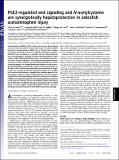PGE2-regulated wnt signaling and N-acetylcysteine are synergistically hepatoprotective in zebrafish acetaminophen injury
Author(s)
North, Trista E.; Vedder, Lea M.; Lord, Allegra M.; Wishnok, John S.; Tannenbaum, Steven Robert; Zon, Leonard I.; Goessling, Wolfram; Badu, I. Ramesh; ... Show more Show less
DownloadTanenbaum-2010-PGE2-regulated wnt signaling.pdf (1.140Mb)
PUBLISHER_POLICY
Publisher Policy
Article is made available in accordance with the publisher's policy and may be subject to US copyright law. Please refer to the publisher's site for terms of use.
Terms of use
Metadata
Show full item recordAbstract
Acetaminophen (APAP) toxicity is the most common drug-induced cause of acute liver failure in the United States. The only available treatment, N-acetylcysteine (NAC), has a limited time window of efficacy, indicating a need for additional therapeutic options. Zebrafish have emerged as a powerful tool for drug discovery. Here, we developed a clinically relevant zebrafish model of APAP toxicity. APAP depleted glutathione stores, elevated aminotransferase levels, increased apoptosis, and caused dose-dependent hepatocyte necrosis. These outcomes were limited by NAC and conserved in zebrafish embryos. In a targeted embryonic chemical screen, prostaglandin E2 (PGE2) was identified as a potential therapeutic agent; in the adult, PGE2 similarly decreased APAP-associated toxicity. Significantly, when combined with NAC, PGE2 extended the time window for a successful intervention, synergistically reducing apoptosis, improving liver enzymes, and preventing death. Use of a wnt reporter zebrafish line and chemical genetic epistasis showed that the effects of PGE2 are mediated through the wnt signaling pathway. Zebrafish can be used as a clinically relevant toxicological model amenable to the identification of additional therapeutics and biomarkers of APAP injury; our data suggest combinatorial PGE2 and NAC treatment would be beneficial for patients with APAP-induced liver damage.
Date issued
2010-10Department
Massachusetts Institute of Technology. Department of Biological Engineering; Massachusetts Institute of Technology. Department of ChemistryJournal
Proceedings of the National Academy of Sciences of the United States of America
Publisher
National Academy of Sciences (U.S.)
Citation
North, T. E. et al. “PGE2-regulated wnt signaling and N-acetylcysteine are synergistically hepatoprotective in zebrafish acetaminophen injury.” Proceedings of the National Academy of Sciences 107 (2010): 17315-17320. ©2010 by the National Academy of Sciences.
Version: Final published version
ISSN
1091-6490